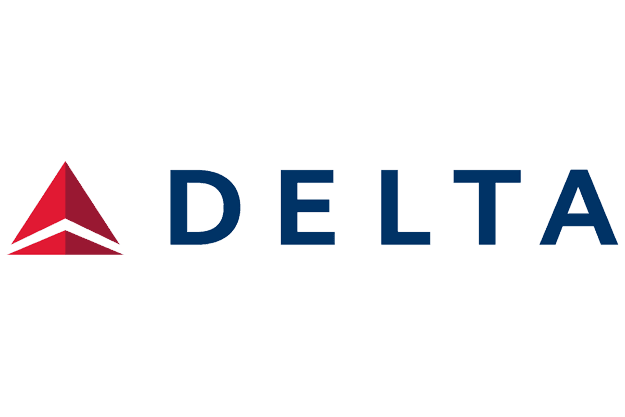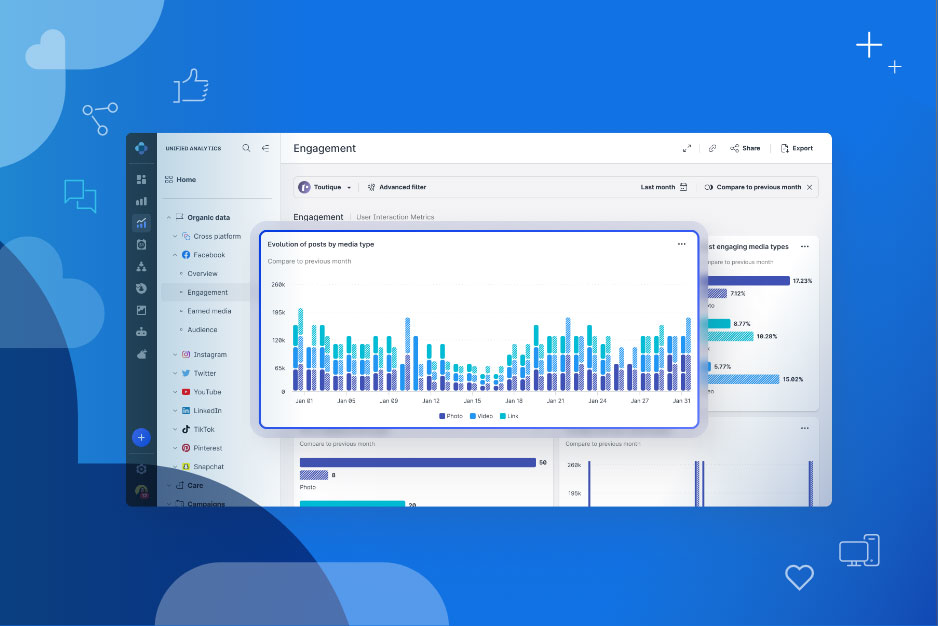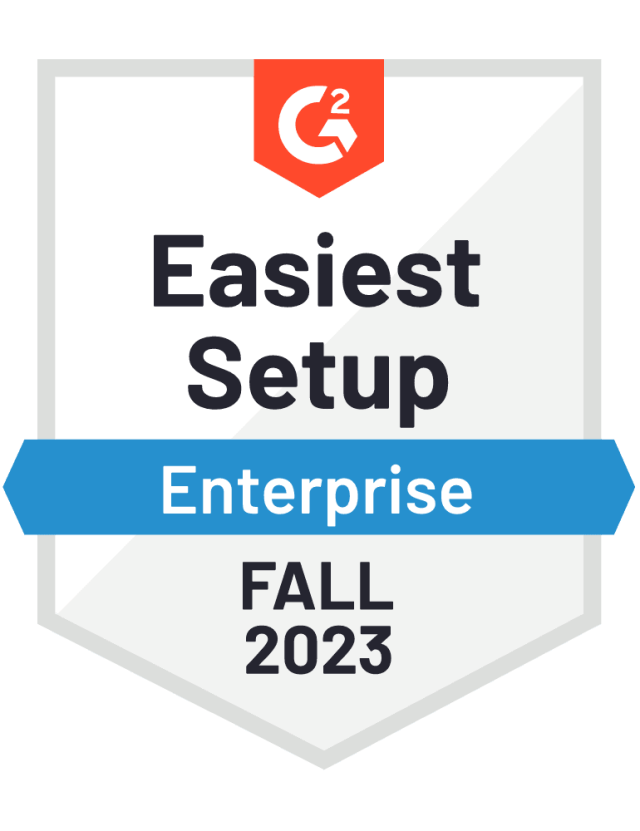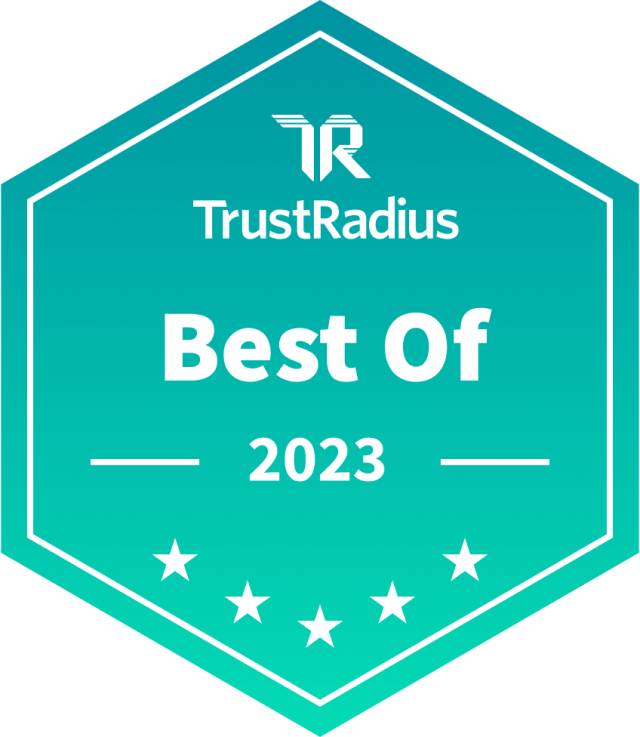With social media marketing now playing such a core role in overall marketing success, social media analytics and campaign measurement tools are critical sources of strategic marketing information.
With so much consumer information being shared on social media every day, social listening tools have become a critical component in audience analysis, competitive research, and product research.
The heart of social media analytics is the gathering and analyzing of marketing and audience data to inform business decisions – a process that is considerably more efficient with a unified customer engagement platform. Analysis of unified social media and customer engagement analytics is the only sure way to access insights that you can use to optimize your marketing efforts across the entire customer journey, influencing brand, demand, and even product strategy.
What is social media analytics?
Social media analytics is the gathering and analysis of data points from social media networks to help inform your social media strategy and optimize engagement around your organic and paid social media efforts.
Ultimately, social media analytics help you answer the ever-important question: Is your strategy working? Some of the many other questions it also helps answer include:
Do you know the social media trends that are relevant to your space?
Do you have a way to quantify the kind of ROI you’re bringing in with each campaign or post on different social media channels?
Do you know what your audience expects and wants from your content and messaging? How is your content perceived in comparison to your competitors?
What are your competitors talking about?
How efficient are we being in delivering the results we want?
Are customers engaging with us on social media, and are we listening to them?
Are our social media analytics shared between different departments like commerce and customer care?
Do we have one view of our customers and their journey to conversion?
Social media analytics software is critical because it can answer every single one of the aforementioned questions. With the right software, a single platform can answer them for every social channel in an easy-to-understand way – no complex data analysis, just a clear presentation of what’s working, and how you can fix what’s not.
This all calls back to a truth that all marketers understand: without measuring and analyzing your content and its performance, there’s no sustainable way to improve your results, or even put your results in the proper context needed to understand if they are good or bad.
Social media marketers need a data-driven roadmap to mark the path ahead so they know where to go and what to do – this is what every social media analytics solution aims to provide, to varying degrees of success.
Social media analytics requires the right tool
Despite playing such a fundamental role in performance and success, true social media analytics solutions still remain heavily underutilized. Many businesses are still failing to take advantage of these platforms, using only native tools that provide shallow performance metrics for each of their channels in isolation. These businesses miss out on a multitude of more in-depth metrics in addition to all of the data points and insights that are derived from contextualizing social media data across channels and industries.

Insights must also be shared amongst stakeholders and between any customer-facing teams; and it can be a real grind to provide accurate and clear social media analytics reports without a tool that can both extract and share data and insights from multiple, disparate social channels, and present that information in an efficient, intuitive, and unified way.
CMOs must provide their teams with the right analytics tools. If they don’t, their business can fall further and further behind, especially as more and more of the competition starts to leverage the increase in consumer data being posted to social channels, and the corresponding advancements in social media marketing software. It’s time to get serious about analytics or be pushed out of the way. The more complex our modern consumers become, the more important it becomes to unify your social media analytics to quickly and efficiently react to those consumers.
For the rest of this guide, we’ll work from the standpoint that social media analytics are fundamental to the content marketing success of any business. We’ll be taking a closer look at exactly why this statement is true.
According to a Forrester study commissioned by Google, only 43% of firms have unified cross-platform analytics, which brings in the full customer experience with their website and app in one solution.
That means that more than half of marketers are missing the means to achieve their #1 objective. A good analytics tool is intuitive, easy to use, improves transparency, and processes and structure too so marketing activities and strategy become sustainable and scalable.
In addition to undertaking daily tracking, monitoring, and analysis of metrics and data trends, a good analytics solution provides an overview of your social media performance, so you can see where strategic opportunities exist, and where threats need to be nullified with adjustments to strategy.
Four reasons why social media analytics is essential
Before we dive into the details of the specific metrics you’ll need to analyze, and how to interpret and make decisions based on these metrics, let's take a look at four critical and universal use cases for a social media analytics solution.
These use cases demonstrate why social media analytics is so crucial for brands, and every good analytics platform will be built and developed with these use cases in mind.
1. Measure and prove ROI and marketing impact
The bottom line of analytics is that they give you instant feedback about how your company is performing across social media channels and whether the strategy your teams are executing is effective. Overviewing performance KPIs is essential to the success of your social media campaigns.
If your strategy isn’t working, then your data analysis will point you in exactly the right direction so you can make effective strategy tweaks before performance dips or becomes a real problem. Catch any downward turns fast, and remedy them right away. Maybe your internal teams aren’t connecting customer pain points, or perhaps your brand content requires more proof to convince potential customers.
Clear overviews also allow CMOs, or anyone across the organization, to quickly and easily see the most important metrics and evaluate marketing performance, so everyone’s working from the latest data.
It’s logical to seek to understand if the resources you’re investing in social media (for example, paid content promotion) are bringing in revenue – directly or indirectly. A full 61% of marketers still struggle to prove ROI from their marketing efforts.
The right tools are as important as the right method of calculation when it comes to ROI on social media. To make things easier:
Add a Facebook tracking pixel to your site’s key pages, and any page linked to from your social channel. This allows you to accurately attribute conversions and actions to specific content or campaigns, even if the user converts days or weeks after first reading your content. If users don’t convert, the Facebook pixel allows you to conduct remarketing campaigns, targeting users who have already visited specific pages before but failed to take action.
Add Google Analytics UTM parameters to your social ads’ URL to understand how much traffic and how many conversions your social media marketing activities are driving.
Emplifi Ads Benchmarks help you measure your social media ROI in context by understanding how the return on Facebook ads (or Instagram ads) evolves across regions and industries over the course of a campaign, or any period of time you choose.
Emplifi’s Unified Analytics allows you to quickly track all your campaigns in one place, so there’s no confusion around content and advertising performance. Analyze cross-channel campaigns, influencer marketing reach, user-generated content (UGC) performance, or individual paid ads, to save time and optimize budget. There are so many moving parts within paid campaigns, but this solution gives you maximum transparency and actionable insights.
2. Make better strategic and business decisions
Strong social media analytics will obviously provide marketing teams with data and insight that helps them identify what’s working and what’s not when it comes to social media and content strategy. However, social analysis tools also provide vital insights that help inform strategic decisions outside of marketing.
This holds more and more true every year, as the amount of data being posted to social media is steadily increasing, along with our ability to extract useful insights from this data as technology improves. Here are some examples of how social media analytics can help improve key decision-making both inside and outside of marketing:
Social listening – The best social listening tools help tremendously with competitive and audience analysis. Social listening is the process of analyzing and parsing the vast amounts of data posted to social channels every day, and automatically extracting useful insights relevant to one’s business.
Social listening allows marketers and analysts to understand how audiences feel about their brand, product, or industry. These insights can help inform product decisions (e.g. “lots of people are complaining about this feature”), shed light on the interests and values of your demographic, and uncover trends relevant to your industry as they happen.
Respond to trends in a timely manner – Access real-time data so that you can rapidly act upon bigger trends and get the jump on competitors.
Minimize business risk – Data is there to signpost your strategic path and show you the right direction, so let data guide your decisions and help you make the best use of your resources and be led by your performance KPIs.
There is little room for emotion in your decisions – base your strategy on data. This will really save your team from wasting time on efforts that yield no worthwhile business outcome. Save resources and time for where you can make the most impact.
3. Compare your social media performance against competitors
What is the point in celebrating good performance if you have no idea whether it’s better than your competitors' performance or how it looks set against average industry performances? It’s pure vanity to do so, and metrics that stand alone have no bearing on real success.
Context is so crucial so, to measure real success, companies must compare themselves to competitors, and also to industry and regional performance averages.
Benchmarking always provides key insights and allows you to see how you stack up against the competition, or see how your performance looks against your industry or region averages.
4. Track marketing teams’ efficiency
Streamlined workflows are key to running a tight marketing crew, so being able to overview team efficiency and velocity is essential to guide them in the right direction. Keep working velocity high and strictly no bottlenecks. This is especially true in areas like community management and online customer service where a good tool will allow you to measure key community management KPIs like response time and audience sentiment.
Businesses need to understand that the customer journey can be tricky to manage in today’s world, and one wrong step can spell disaster. Or at least a social media crisis, which – let's face it – is a disaster.
Micro-management is a thing of the past, and with a good analytics solution teams can easily report on exactly the metrics their CMO wants to see, and from the other side, the CMOs can easily overview marketing operations, see crucial top-line data (or even granular), and spot trends that need further investigation by the marketing team.
Key areas to use social media analytics
Many social media teams don’t know exactly which areas of their social media marketing can really benefit from analysis, so let’s have a look into exactly where you should be measuring, and why.
Here are the key areas:
Audience analytics
Everything begins with your audience. Knowing your business’s target audience is critical. It helps you build an effective, audience-first marketing strategy that helps you nurture your communities down the funnel and deliver great customer experiences.
You must know what your customers want and how they respond to your efforts in attracting them to your product/service.
Understanding your audience plays a big role in your brand’s bottom line. After all, 49% of online shoppers rate receiving excellent communication on social media as “very important” when making a purchase. This shows that audience analytics from social media is necessary in order to deliver excellent communication.
In the past, marketing leaders didn’t have too much insight into their digital audiences. That’s because audience data was scattered across individual social media platforms and on the web. It took an experienced analyst to bring it together, map out personas, and report on them to the CMO.
On top of that, each audience on each channel is different with different audiences, and there wasn’t an easy way to connect all that audience data and segment audiences effectively in a sustainable way.
Now, certain tools allow marketers to instantly see who their digital audiences are, their ideal customer, and ensure that their broader marketing strategy is aligned with the personas’ characteristics, interests, and behaviors. They can also leverage the insights to reach new audiences and create many more business opportunities.
The next question is: Can you measure your performance levels as they rise and fall? And the answer is yes. You can and you must.
For a more in-depth look at what audiences expect from your brand, download Emplifi’s latest report on what consumers expect from brands.
Social media performance analytics
Measuring your own performance is key to understanding where your strategy is working and bringing good ROI, and where it needs some fixes.
If you’re like other businesses, you’ve significantly increased your social media marketing budget over the past year. Emplifi data shows that median monthly ad spend among brands reached a 15-month high of $5,380 in Q4 2022.
At the same time, eMarketer projects that global digital ad spend will reach almost $700 billion by 2026.
If you’ve invested more in social media marketing, you naturally expect to see increased ROI, but you need to prove your performance’s impact on ROI. You don’t need to get too granular early on, and you don’t need to know how many people liked or shared your latest Facebook post. What you need is a more high-level overview of bigger trends.
Key performance metrics to track:
An overview of interactions across platforms and over time to understand if the content you’re publishing is effectively engaging your audience.
Look at both the cumulative number of interactions and the number of interactions per 1,000 followers to see how big of a share of your community is responding to your messaging.
Zoom in on the number of click-throughs on your posts to learn how effectively you’re driving traffic from social to web.
Monitor your follower growth over time to see if your audience is growing as a result of your teams’ social media efforts. You want to grow your customer base, so it’s important that you consistently gain new followers.
Again, it’s really important to track all these metrics over time to spot bigger trends, understand the results of your organization’s social media strategy, and see what return you’re getting from your investment.
Competitive analytics
Nearly every CMO is interested in improving their performance in two key areas: effectiveness (producing the desired result) and efficiency (reducing waste), but often they don’t know how much they need to improve.
Comparing your company’s social media performance to the competitors is the best way of assessing the effectiveness of your teams’ work and strategy. It also enables you to learn if your performance and ROI are successful in relation to the market.
If there’s a specific company you want to get ahead of, you can run a head-to-head analysis of your performance. But you can also compare yourself to multiple competitors to see how you stack up.
It’s best to run competitive analyses regularly to keep a close eye on what your competition is up to, and to advise your teams on what strategic steps they can take to help your business stay a frontrunner.
With modern social media analytics, especially if they’re AI-powered, you can use a benchmarking solution that lets you see your competitors’ performance based on industry, country, and region. You can see their strategy and easily get ahead of them.
It’s easy for businesses to neglect this side of analytics but, again, they should remember that even if they aren’t doing competitive analysis, their competitors probably are.
Paid social media analytics
According to Statista, social media ad spend is projected to reach $450 billion in 2024. At the same time, a HubSpot report found that 79% of marketers said that they buy paid social ads, which shows that it’s a viable form of advertising. The catch is that analytics from paid social strategies need to be deeply understood for this strategy to work.
A lot of money is being spent, so it’s absolutely critical that businesses know the effectiveness of their social media ad spending. You need to be able to make efficient investments and ensure that every dollar you spend on social media counts.
It’s all too easy to waste time and resources on promoting content that performs badly if you have no idea what paid content your audience will respond well to.
Some businesses use AI-driven tools and automation that accurately predict which content to put budget behind for the best results – and early adopters are seeing great results with this.
Paid social media advertising can seem very complex with so many moving parts, and reporting on ad spend can be complicated with so many channels, accounts, and profiles. So to keep an eye on spending, it’s vital to bring all your channels into one place before you start measuring.
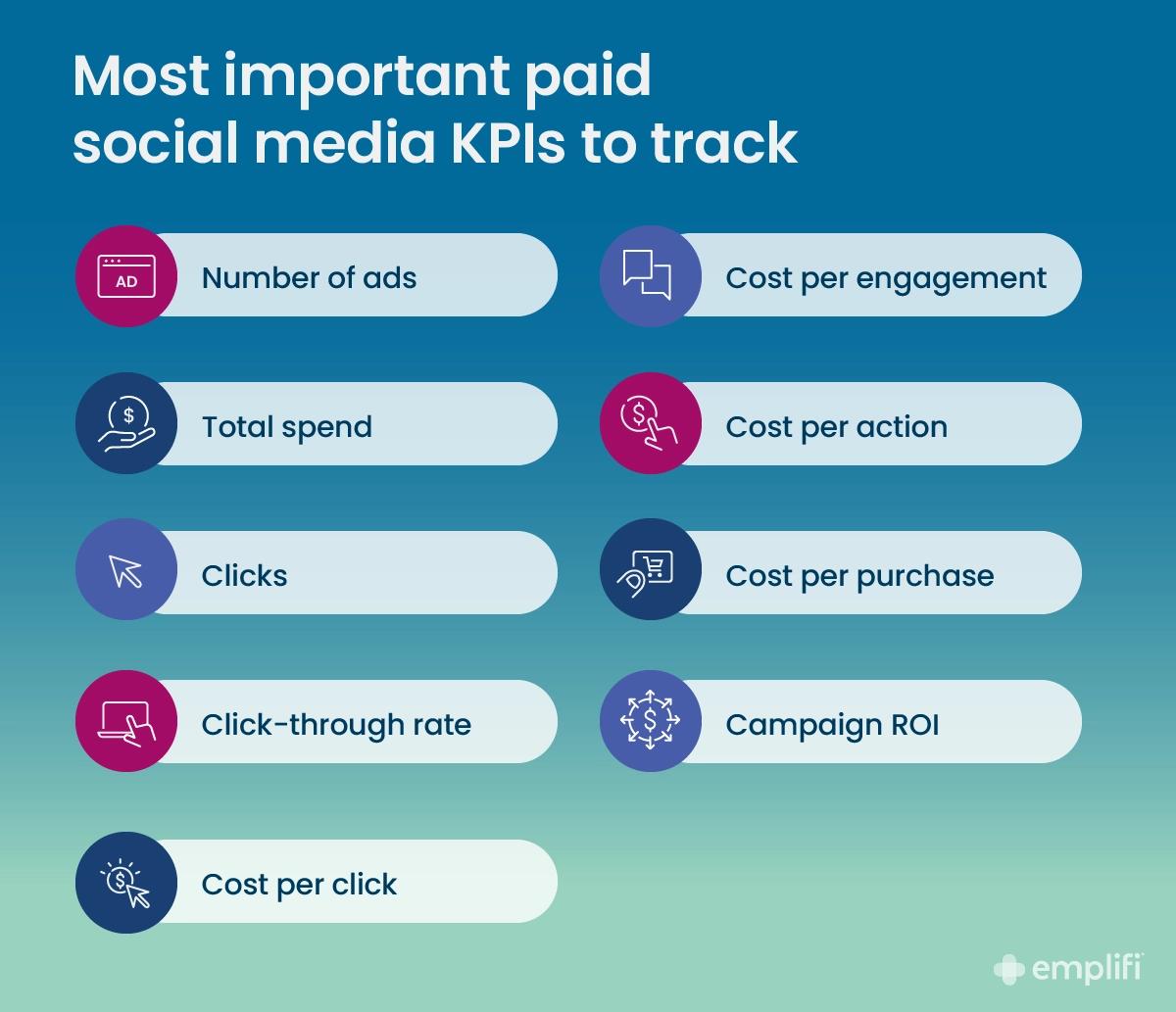
These KPIs will show you exactly where your money is going, and how much you’re paying for different aspects of your advertising campaigns and how successful your efforts are.
To get a more complete picture of your advertising spend, you should compare yourself to your competitors’ spend, and also to the industry, region, or country average. You’ll be able to see if your advertising budget is sufficient to stay competitive, and assess where your ad strategy needs to be optimized to increase its efficiency and reportable impact. But the data must be current; it’s not enough to rely on monthly reports.
For more, explore our detailed step-by-step guide on how to get the most from your paid advertising.
Customer service and community management analytics
A recent report from Statista shows that 81% of US consumers would leave a brand they’ve been loyal to after as few as two poor experiences.
Additionally, 52% of consumers expect a response from brands within one hour of them reaching out with a question or concern. In fact, 1 in 10 expect a response within only five minutes. This shows that your brand needs to have a strong pulse on your customer service analytics so that you can engage with your audience accordingly.

These consumer expectations also underscore the need to ensure that your teams are doing an excellent job handling customer requests. How? Look at your community management teams’ key performance metric – average response time – and see how it looks for each team member and platform.
By monitoring your community management teams’ performance metrics, you can ensure that your business communication is appropriate and timely. This, in turn, translates to enhanced brand image and stronger, lasting relationships with your customers and prospects.
It’s so important to nurture your audience across all digital touchpoints which means keeping an eye on how fast your team answers and solves customer queries, and how audience sentiment fluctuates around your brand.
It’s also crucial to track sentiment, as it’s such an important aspect of customer care, but there’s more about that in the sentiment analysis section a bit further down.
UGC performance analytics
UGC powers modern social content needs and offers a proven boost to brand authenticity. As part of your content strategy, it is important to integrate UGC into your marketing mix and compare its engagement and effectiveness versus other activities, particularly as it is an effective source of social proof across your customer journey.
Unified social analytics offer marketers a way to discover, deploy, and measure UGC across your social and brand channels. It’s also an effective first step to creating shoppable UGC across social channels as content performs well across organic social and can be boosted across any eCommerce touchpoints for your brand.
Marketers should evaluate traditional social engagement rates when considering UGC, identifying top-performing user content from social listening or within activity from your social community. Unified analytics offer a way to streamline this process and connect your internal social steps.
Influencer performance analytics
Hiring influencers can be pricey, so make sure that you spend wisely and collaborate with the right partners on the right platforms, because, for example, how you work with TikTok influencers may be different from other platforms.
You need data to verify influencer choice, and only work with influencers whose performance metrics are high around your key topics. Tracking influencers’ key performance metrics will help you make the right decision and make the most of influencer marketing.
Influencer marketing should be measured just like other parts of marketing. Analytics help you organize every part of your influencer campaigns – from finding the right influencers to measuring how much their campaigns helped your business. But which influencer metrics should you track? Here are some key metrics:
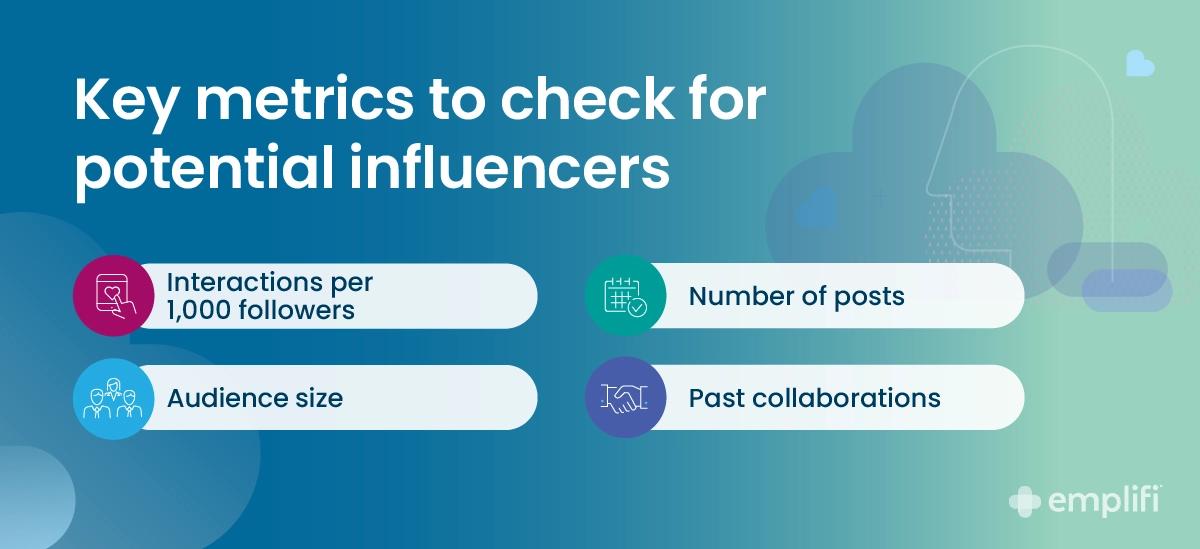
Interactions per 1,000 followers will help you understand if they’re effectively generating engagement, no matter the total size of their following.
Audience size to estimate reach. Reach alone is not enough if the influencer doesn’t have the right audience, which is why it’s crucial to measure their key metrics before deciding to collaborate.
Number of posts, to see how active they are. You should also check the brands the influencer has worked with in the past to verify their authenticity and get a better understanding of the verticals they’re working in.
Have a close look at any past collaborations the influencer has done, and verify that they have a business license. Influencer fraud is on the rise and canny businesses protect themselves by doing their due diligence. See more in this guide on vetting influencers before signing any contracts.
Sentiment analysis of your profiles and ad campaigns
If sentiment isn’t measured, businesses run the risk of alienating their social media audience, and severely damaging their brand perception in the eyes of customers and potential customers alike.
That’s why it’s essential to constantly monitor upturns and downturns in sentiment – you don’t want to turn your fans off and, with sentiment analysis tools, especially an AI-powered tool, you can catch negative sentiment fast and analyze why that sentiment arose.
Social teams run regular content to attract and educate their audience, and get them to enter the sales funnel. It’s therefore essential to treat your social media profiles as long-running campaigns, so of course, sentiment should be closely measured.
It’s going to allow you to make great decisions about content and content strategy based on audience data. Savvy businesses also run sentiment analysis on their advertising campaigns.
Remember, everything begins with your audience and sentiment analysis is the most fundamental social media analysis you can run. Once brand perception has been damaged it’s very difficult indeed to fix, and that’s why it’s imperative that you know if your audience is happy with you and your content or not.
Sentiment analysis for customer service
Sentiment analysis allows you to track online mentions in real-time, so it’s really easy to see if a potential PR crisis is starting to take shape. Businesses can rapidly identify any spike in negative sentiment, and they can immediately investigate and take action to defuse it.
Word spreads fast on social media, and negative comments get the most attention and spread the fastest. Failing to deal with unsatisfied customers is risky; they may share their anger on a wider scale on their social media accounts. That’s something you want to avoid at all costs.
Remember, you can filter by individual sentiment: happy, sad, or angry, decide upon your priorities, and begin soothing your audience wherever it’s needed most. However you manage your sentiment analysis, the key is to nip negative sentiment in the bud early, and protect your brand.
How to track your key performance insights quickly and easily through unified analytics
It’s important to have the right views over your data. Customizable dashboards help you see only the metrics that matter to you at any particular moment. Dashboards join up the dots for you and deliver the insights that are crucial to strategy.
Imagine this: You export data from Facebook, Instagram, or elsewhere and analyze it all separately, working around data gaps, trying to put the jigsaw puzzle together and figure out what the heck is going on. Then you try to create a report that clearly visualizes the key data insights, the ones that are going to impact strategy.
Or, imagine this: All your data is pulled your unified analytics dashboard. The dots are connected for you and the story the data is telling you is neatly translated and delivered in shareable, presentation-ready reports.
With dashboards you can easily view all of your metrics in one spot. You have all the insights at your fingertips in real time. Marketing teams can stop worrying about messy or incomplete reporting, and instead set up automated, visual reports to share with higher-ups so everyone’s working from the same page.
That’s the power of unified analytics. Your internal teams – anyone who manages brand touchpoints or who could benefit from customer insights pulled from social media – will all understand your customer interactions, engagements, sentiments, and behaviors through comprehensive views. Your brand will track total performance and align on KPIs.
The takeaway: Unified data leads to actionable insights
Social media analytics are essential to social media marketing and understanding a complete picture of the modern consumer. There’s no point in marketing if you cannot see whether you’re doing well or not.
Measurement and analysis enables you to prove your impact, constantly improve performance, optimize budget, create strategy, and form genuine relationships with your audience that will nurture them through every touchpoint on the way to purchase.
If you’re a content, digital, growth, or social marketer, the message is clear: track, measure, analyze, and make sure you have the social media analytics tools to do it.
Want to explore how Emplifi can help you connect the power of unified analytics? Request a demo today to speak with an Emplifi expert.

